For those who pay attention to such things, apologies for being late this week (completely on me, not the other guys), and a note that we’ll be skipping Thanksgiving week, so our next column will appear on Friday, November 30th.
Shadowman #1 (Valiant, $3.99)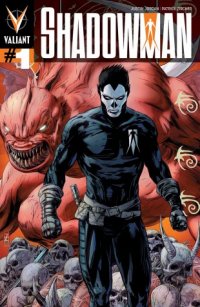
by D.S. Randlett (@dsrandlett)
It looks like the eighties’ turn is nearly over in terms of our current nostalgia sweepstakes. We’ve had reboots of varying quality from properties like Thundercats, Transformers, He-Man, G.I. Joe, and others. Now it appears that it’s the nineties that are roaring back to meet us with a new coat of paint. DC’s New 52 has itself folded in the Wildstorm Universe, with Helspont from WildC.A.T.s making a return (apparently as a big bad for Superman). Also, actual WildC.A.T.s team members, along with characters from that time in Warren Ellis’ career when he was writing JLA parodies. The results of these developments has been dubious at best, but this emerging trend has given us titles that are rather good, like Prophet and Glory from Image.
So naturally, Valiant has managed to reemerge, I’d imagine after a lot of legal wrangling, but without their staple Gold Key characters (Magnus, Solar, and Turok). This presents a sort of uphill climb for the company, as those were the best Valiant characters in the nineties, really, mainly because they weren’t really superheroes. This foundation infected the entire line and actually made it kind of unique for the era, resulting in a superhero universe that pulled liberally from other pulp genres. The entire line has actually been pretty good so far, with Archer and Armstrong being a real standout with its embrace of humor and whacky conspiracy theories. These have definitely been superhero books, but they’ve managed to mix a sense of fun and a sense of maturity rather deftly (not to mention really good art across the line) which makes them worth watching, if not yet must reads.
So here we have the next entry into Valiant’s first relaunched year, the long awaited Shadowman. He was never a character I was into as a kid, probably because of his Kenny G haircut and his propensity to be sitting on a parked motorcycle wailing on a a saxophone (god, it really was the nineties) in almost every piece of promotional material. So I never really had a sense of what the character was really about, but I was aware through the years of his becoming a cult favorite. In get togethers with other geeks, Valiant would always come up, and other than Turok, Shadowman was the character that would receive the most admiration for his mixture of Chris Claremont and Anne Rice.
The first issue of the new series definitely has a minor case of first issue-itis, but there is plenty of encouraging stuff. For one, this isn’t afraid to be splattery horror book. There’s a pretty gruesome scene in a nightclub that reveals a baddie with shades of Motley from Perdido Street Station and Grant Grant from Slither, which just shows good taste. The design of Shadowman himself isn’t quite as distinctive as the nineties incarnation (also, not nearly as goofy), and isn’t as otherworldly as one would expect from a hero with origins as… exotic as his. There’s not much to say about the plot, sadly. Jack Boniface is a lost young man in New Orleans trying to find out the secret of his parents’ deaths, and also who they were. In frustration, he ends up throwing away an amulet he’s worn all of his life, and the kicks off a series of events where he finds out that he’s the latest in a line of Shadowmen. We don’t know exactly what that means for Jack, yet, but judging from some rather cool flashback scenes we can surmise that it is his duty to protect the mundane world from darkly magical threats like zombies and demons. If you’ve been reading Animal Man or Swamp Thing, much of this will feel familiar. If you haven’t, it will still feel familiar. All in all, it’s pretty derivative stuff and the dialogue can be rather stilted, but there are still flashes of potential here and there.
While the story is nothing to right home about, the art is really damn good. There’s a scene in the first few pages that involves a previous Shadowman fighting off a horde of zombies/demons that’s particularly thrilling and well done. Brian Reber’s colors really pop and bring life to everything with some really wonderful interplay between shadow and light.
Shadowman is entertaining and well worth a look, but time will tell if it lives up to its predecessor’s cult reputation.
Rating: 




Out of a Possible 5 Stars
 Great Pacific #1 (Image, $2.99)
Great Pacific #1 (Image, $2.99)
by Graig Kent
It’s amazing how much damage humanity can cause in such a short amount of time. As a race, we’ve long been fixated with consuming and self-satisfying, often unaware, or else remaining willfully ignorant, of the greater impact satiating our wants and desires has on our ecology. From the introduction of rabbits to Australia in the 18th century to the hunting out of the buffalo in 19th century North America to, most drastically, the rise of both consumer and disposable culture in the 20th century, we irrevocably change the world’s landscape only to feel the effects thereof long after we’ve passed the point of being able to course correct.
The biggest problem is, even after identifying the problems we’re creating, our responsiveness to change, in the face of commercial, political and social pressures, is piss poor. I’m no less guilty than most anyone else, my steady diet of consumerism will probably be passed along to my kids, because, hey, it’s fun to have stuff while it lasts. I would love to change, but I think that most “first worlders”, myself included, are waiting for a solution that both fixes the problems we’re causing and also doesn’t require us to change our habits all that much.
Great Pacific touches upon the bulk of these ideas I present above. Its title refers to the Great Pacific Garbage Patch (and let’s just be very clear that the use of “great” here refers to “vast” or “expansive” rather than, you know, “awesome” or “fantastic”), an indeterminately-sized mass (that may be anywhere from 700,000 square kilometers to twice the size of the continental United States) comprised largely of nugget-sized bits of plastic [see this brief but fascinating Ted Talk video for more]. In story the mass is much more physically tangible than it is in real life, virtually a new continent made up of plastic bottles and other oil-derived refuse.
The story’s protagonist is Chas Worthington, the young heir to his recently deceased father’s major share in Worthington Energy, one of the world’s top oil companies. Chas is a silver spoon playboy, a frequent absentee voter on the board of directors, and a man of vision. Chas wants to exploit environmental catastrophe for his own commercial gain. He’s had his company’s R&D department developed a prototype plasma beam that converts crude into water vapor, and when it finally starts working he’s convinced the Great Pacific Gyre is the next Texas. It’s a risky, heavy initial investment which naturally the short-sighted, status-quo maintaining board would never go for, so Chas concocts a rather extreme plan to escalate his new venture immediately.
I enjoy fiction that finds clever ways of dealing with our societal shortcomings without being preachy about it, and Joe Harris has devised a fascinating — if somewhat factually fudged and super-scienced-up — story that does just that. Harris starts a fantastical but embarrassingly real facet of the real world pushes it gently into speculative fiction territory, a “what if?” scenario that’s more “why not?” Chas, as a protagonist, is a strong character, and the opposition he faces in achieving his goal is naturally varied and sizable. Harris’ storytelling isn’t always the cleanest (early narration comes from an uncertain source, some dialogue sequences are awkward and unnatural) but largely the story is a winner — fascinating and enjoyable.
Harris is joined by Martin Morazzo, who came into the comics scene by way of the late Zuda comics. He’s an exceptional artist, albeit wearing his Frank Quitely influence prominently on his sleeve. His lines are lean and clean, angular, minimally used, but purposeful. His attention to detail is impressive, from the mammoth garbage piles in the Gyre, to the grasses of Africa, to the boardrooms in Houston. Harris takes Chas across the United States and around the world, in a myriad of locales in these 31 pages, and Morazzo is more than up to the task of presenting them all.
It’s a fascinating and intelligent debut issue that uses the medium and genre in smart and effective ways. It will be interesting to see if Great Pacific remains rooted in a quasi-reality, or if it starts shifting to “out-there” proportions. Either should work quite well.
Rating: 




Out of a Possible 5 Stars
Now, Now, Now… Now.
By Jeb D.
Fantastic Four #1: (Marvel, $2.99)
Thor God of Thunder #1: (Marvel, $3.99)
All-New X-Men #1: (Marvel, $3.99)
X-Men Legacy #1: (Marvel, $2.99)
Every now and again, we do well to be reminded of just how thin is the veneer of creativity that overlays the corporate underpinnings of the Big 2 superhero universes. The other day, I was with my nephew at Target, and spotted a Fantastic Four action figure set that consisted of Reed, Sue, Ben… and H.E.R.B.I.E. instead of (not in addition to) Johnny Storm. That’s right: after all these years (decades!), there are still contracts out there tied to such arcane foundations as the licensing deal that broke off the Human Torch for his own product line, forcing the creators of the animated FF TV series to come up with his cuddly robotic replacement (and who eventually became a part of the comic-book team, and who made an amusing co-star in Chris Eliopoulos and Marc Sumerak’s Calvin and Hobbes-like Franklin Richards strip, until the idea was, predictably, run into the ground). It’s not that one is surprised or disappointed at seeing the bottom-line decisions that drive today’s writers and artists laid bare; it’s that one marvels (so to speak) that cash-grabs like New 52 and Marvel Now! ever produce anything worth reading at all. Thus, this week’s batch of Marvel Now! relaunches.
While Jonathan Hickman built his Fantastic Four epic slowly and majestically, Matt Fraction 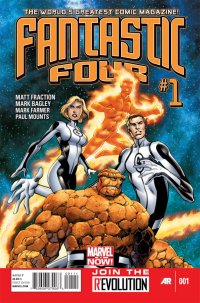 jumps aboard with both feet: something’s physically wrong with Reed, he’s had intimations of disaster ahead (as has Franklin, though Reed doesn’t know this yet), and in his quest for answers, he’s leaving behind the mundane “known” universe (or collection of universes) in which his team dwells for an exploration of “unknown” universes, and taking the whole fam dambly with him. While I can understand those who were disappointed that Hickman’s grand vision wound up leaving the status quo pretty much unchanged, I think that undervalues the wondrous journey that his books were for the past few years (and let’s face it, changes like Clark Kent’s place of employment, or Spidey’s latest wardrobe malfunction, are rarely more than gimmicks that come in for justified criticism; I’m personally glad Hickman eschewed that sort of thing). And at first glance, Fraction seems to be taking the opposite route, jumping headlong into new possibilities, and strongly suggesting large-scale changes ahead; again, if that’s his goal, he’ll have to balance novelty and innovation against the longtime strengths of the appeal of the original Lee-Kirby concept.
jumps aboard with both feet: something’s physically wrong with Reed, he’s had intimations of disaster ahead (as has Franklin, though Reed doesn’t know this yet), and in his quest for answers, he’s leaving behind the mundane “known” universe (or collection of universes) in which his team dwells for an exploration of “unknown” universes, and taking the whole fam dambly with him. While I can understand those who were disappointed that Hickman’s grand vision wound up leaving the status quo pretty much unchanged, I think that undervalues the wondrous journey that his books were for the past few years (and let’s face it, changes like Clark Kent’s place of employment, or Spidey’s latest wardrobe malfunction, are rarely more than gimmicks that come in for justified criticism; I’m personally glad Hickman eschewed that sort of thing). And at first glance, Fraction seems to be taking the opposite route, jumping headlong into new possibilities, and strongly suggesting large-scale changes ahead; again, if that’s his goal, he’ll have to balance novelty and innovation against the longtime strengths of the appeal of the original Lee-Kirby concept.
This first chapter is driven by flash-backs and flash-forwards, frightening dreams, and comic relief. Fraction’s decision to provide each member of the team with an on-the-nose character moment (Sue nurturing, Ben enraged by the Yancy Street Gang, Johnny utterly full of himself) comes off a bit abruptly, but I suppose that’s what renumbering does: if this is someone’s first issue of a Fantastic Four comic (statistically unlikely as that may be), the reasoning goes, they need to be quickly brought up to speed on just why these characters have endured for half a century. The problem, of course, is that Lee and Kirby had some time to work all these relationships out (the early Ben Grimm, in particular, is nearly unrecognizable compared to the character we know today, and it took years for Sue’s potential as wife and mother to be realized)—heck, they even had more pages per issue for that kind of thing. Fraction’s past work suggests that it’ll be worth sticking with the book to see what he has in store, but I’m hoping for more of the Hickman-style ground game than what we’ve seen so far. Artist Mark Bagley turns in his usual capable job: he’s never been one to excite me, but he tells a decent story and he’s rarely showy or pointless; inker Mark Farmer lends something of his Alan Davis-inspired grandeur to the characters, and colorist Paul Mounts’ work is engaging and attractive. I might be more enthusiastic about Fraction’s turn with the Fantastic Four if we hadn’t already had a sneak peek at his upcoming FF series (with Mike and Laura Allred): that one seems to be a much better use of his time and imagination.
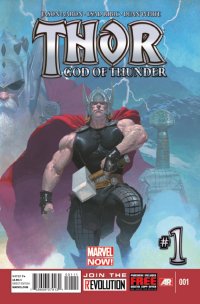 If Robert Downey Jr.’s Tony Stark is arguably the Marvel movie-verse’s greatest gift to the comics, there’s no question that bleedthrough from the movies has also imbued Thor with one of his more entertaining portrayals, supplanting the brooding Lee/Thomas pseudo-Shakespearean warrior with Chris Hemsworth’s headstrong, cheerfully boisterous lug. But while the onscreen Thor can be engaging despite being far from the sharpest tool in the drawer, he’s a bit trickier as the protagonist of an ongoing series, which is one good reason for Jason Aaron to take on this book; the man who actually made me want to read comics featuring Ghost Rider and Wolverine has also worked up a great premise for this not-quite-Hollywood version of Thor: the Odinson, here, is a time-and-realm-spanning gumshoe, with inquisitiveness compensating for a lack of intellectual brilliance. The implications attendant upon the death of gods and/or God is a headier topic than I’d expect a mass-market Marvel film to take on, and it’s a nice reminder of some of the storytelling advantages that the long-form comics series has over even a well-executed superhero film.
If Robert Downey Jr.’s Tony Stark is arguably the Marvel movie-verse’s greatest gift to the comics, there’s no question that bleedthrough from the movies has also imbued Thor with one of his more entertaining portrayals, supplanting the brooding Lee/Thomas pseudo-Shakespearean warrior with Chris Hemsworth’s headstrong, cheerfully boisterous lug. But while the onscreen Thor can be engaging despite being far from the sharpest tool in the drawer, he’s a bit trickier as the protagonist of an ongoing series, which is one good reason for Jason Aaron to take on this book; the man who actually made me want to read comics featuring Ghost Rider and Wolverine has also worked up a great premise for this not-quite-Hollywood version of Thor: the Odinson, here, is a time-and-realm-spanning gumshoe, with inquisitiveness compensating for a lack of intellectual brilliance. The implications attendant upon the death of gods and/or God is a headier topic than I’d expect a mass-market Marvel film to take on, and it’s a nice reminder of some of the storytelling advantages that the long-form comics series has over even a well-executed superhero film.
Over the course of historic eons, ranging from the young Thunder God fighting shoulder to shoulder with Vikings, to a future where he is a wearied, one-eyed king of an empty realm, Thor is on the trail of a serial killer of gods, one Gorr the God Butcher. Aaron dots the trail with clues as Thor learns of his adversary (the murdered Native American god is more than a bit disturbing), along with some quietly sobering speculation as our hero encounters a world that does not have, and has never needed, gods. Artist Esad Ribic has always been a dab hand with the grandeur of Asgard; here, he adds additional delicious touches of horror that take Thor’s investigation to dark places indeed. One tends to think of any Jason Aaron comic as self-recommending; Thor God of Thunder #1 keeps that streak very much alive.
As noted before, I’m only a casual X reader, so I had limited expectations for this week’s other two 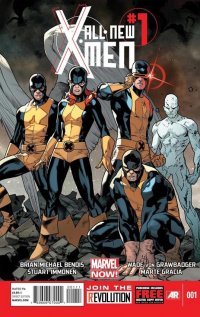 Marvel Now! debuts. Such enthusiasm as I could muster for All-New (yeah, whatever) X-Men #1 was due mostly to my affection for the work of artist Stuart Immonen, and the strength of his previous collaborations with Brian Bendis, and they’ve whipped up a familiar-looking X story here: young person under stress reveals mutant abilities, a team of super-powered beings arrives to beckon them to come away and be safe, misunderstood mayhem ensues, regular cast members hide desperate secrets from the rest, and romance rears its… well, actually, that part of the soap opera (a term I do not use pejoratively, by the way) is evidently being held back for later. And I’m sure there’s an issue of some recent X book that I’ve missed which explains how Scott gets out of prison and teams up with Magneto and Emma Frost to head an evil mirror version of the Jean Grey school, but I’m willing to take that as read. Otherwise, though, it’s basically X-business-as-usual, with Bendis’ usual verbal tics, and lots of vigorous action and simple but strong facial work from Immonen. I can’t imagine this grabbing any new X-reader, but anyone invested in the ongoing tribulations of Beast, Storm, Iceman and the rest will likely find it sufficiently entertaining.
Marvel Now! debuts. Such enthusiasm as I could muster for All-New (yeah, whatever) X-Men #1 was due mostly to my affection for the work of artist Stuart Immonen, and the strength of his previous collaborations with Brian Bendis, and they’ve whipped up a familiar-looking X story here: young person under stress reveals mutant abilities, a team of super-powered beings arrives to beckon them to come away and be safe, misunderstood mayhem ensues, regular cast members hide desperate secrets from the rest, and romance rears its… well, actually, that part of the soap opera (a term I do not use pejoratively, by the way) is evidently being held back for later. And I’m sure there’s an issue of some recent X book that I’ve missed which explains how Scott gets out of prison and teams up with Magneto and Emma Frost to head an evil mirror version of the Jean Grey school, but I’m willing to take that as read. Otherwise, though, it’s basically X-business-as-usual, with Bendis’ usual verbal tics, and lots of vigorous action and simple but strong facial work from Immonen. I can’t imagine this grabbing any new X-reader, but anyone invested in the ongoing tribulations of Beast, Storm, Iceman and the rest will likely find it sufficiently entertaining.
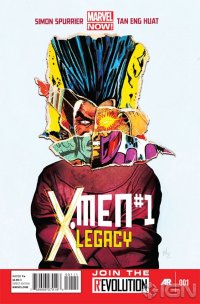 Legion—David, the psychically unstable son of Charles Xavier—is one of the characters who turned up in X continuity while I wasn’t looking, and writer Si Spurrier isn’t taking baby steps introducing me to him in the first issue of the new X-Men Legacy, as his “real” world is laid atop the psychic prison in which versions of himself clash with other, more dangerous “inmates,” while a guru attempts to lead him to a healthier normalcy (and, this being an X comic, with predictably disastrous results). The psychic realm that Spurrier has come up with is intriguingly disturbing; though Tan Eng Huat’s art leans a bit more toward the quirky than the menacing, it does a good job of helping keep the reader off balance, as David begins his journey back to humanity, bringing some pretty scary mental baggage with him. This first issue is more about character delineation than exposition or story development, and readers more familiar than I with Legion, as a character, might get impatient. Otherwise, though, an intriguing beginning, and a welcome alternative to run-of-the-mill mutant mischief.
Legion—David, the psychically unstable son of Charles Xavier—is one of the characters who turned up in X continuity while I wasn’t looking, and writer Si Spurrier isn’t taking baby steps introducing me to him in the first issue of the new X-Men Legacy, as his “real” world is laid atop the psychic prison in which versions of himself clash with other, more dangerous “inmates,” while a guru attempts to lead him to a healthier normalcy (and, this being an X comic, with predictably disastrous results). The psychic realm that Spurrier has come up with is intriguingly disturbing; though Tan Eng Huat’s art leans a bit more toward the quirky than the menacing, it does a good job of helping keep the reader off balance, as David begins his journey back to humanity, bringing some pretty scary mental baggage with him. This first issue is more about character delineation than exposition or story development, and readers more familiar than I with Legion, as a character, might get impatient. Otherwise, though, an intriguing beginning, and a welcome alternative to run-of-the-mill mutant mischief.
Fantastic Four #1: Rating: 




Out of a Possible 5 Stars
Thor God of Thunder #1: Rating: 




Out of a Possible 5 Stars
All-New X-Men #1: Rating: 




Out of a Possible 5 Stars
X-Men Legacy #1: Rating: 




Out of a Possible 5 Stars